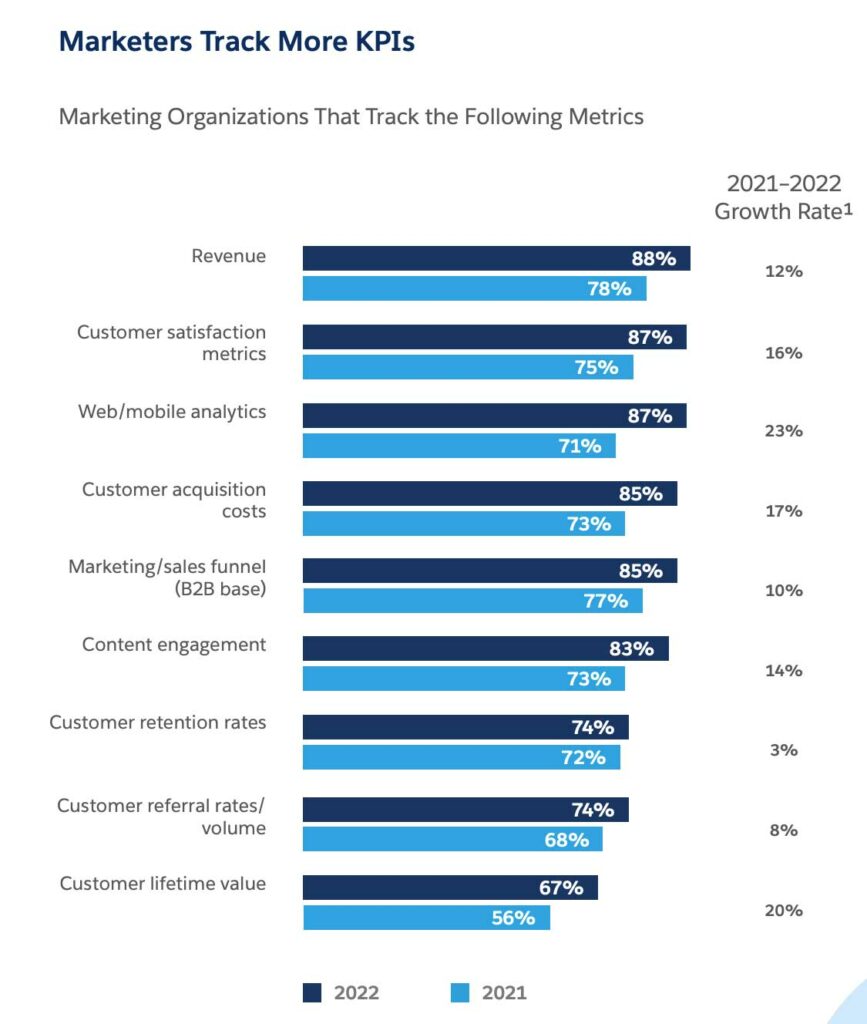B2B marketers are now tracking more metrics than they did in the past, and they’re also prioritizing different KPIs in 2023. So what’s driving these shifts?
This chart from the latest Salesforce State of Marketing Report speaks volumes. There’s a hidden story behind each of these growth rates. We share the top takeaways below.

Takeaway #1: Greater Emphasis on Bottom-Line Results
The number of marketers who track the KPIs “revenue” and “customer acquisition costs” jumped 12% and 17%, respectively. It’s not a head-scratcher: Marketers are being pushed by executives to demonstrate tangible contributions to bottom-line revenue. Success is no longer defined by the number of MQLs generated each month (especially if most of them don’t convert).
A greater focus on marketing-attributed revenue is a good thing, but it’s also unnerving because of the difficulties of tracking ROI/marketing attribution, ranked as the #2 challenge by the Salesforce report. How revenue is tracked—and by whom—will continue to evolve with the rise of revenue marketing and integrated revenue teams (marketing, sales, CX).
Takeaway #2: Digital Engagement KPIs Require Closer Inspection
Wow, a 23% increase in the number of marketers that track web and mobile analytics? A number of factors are likely driving this big jump:
- Greater digital focus overall: All marketing became digital marketing during the pandemic, when tactics shifted dramatically and digital engagement skyrocketed. That digital focus continues into 2023.
- Expanded personalization: More marketers recognize the importance of personalizing the customer experience, and that requires close attention to web and mobile analytics, and tracking customer touchpoints in greater detail.
- Content drives the buyer journey: Buyers are consuming more digital content than ever before. That reality is reflected in the 14% increase in marketers who track “content engagement.” Marketers need to understand what content is resonating and pay closer attention to the end-to-end content experiences they’re creating for buyers. A wider cross section of web metrics can also help marketers prove content ROI more convincingly.
- Emphasis on data collection strategies: Marketers need to refine their zero- and first-party data collection strategies as they prepare for cookies to go away. That requires closer attention to content engagement and other web metrics.
Takeaway #3: Existing Customers Get More Attention
Have marketers neglected existing customers by focusing too much on lead generation and new customer acquisition? Maybe. But the increase in these customer-focused KPIs shows that more marketers recognize the critical importance of customer marketing for retention and upselling, especially in an uncertain economy where marketing budgets are tight. It costs far less to retain a customer than it does to acquire a new one. So the 20% increase in marketers that track “customer lifetime value” is a positive trend. The buyer journey doesn’t end at the purchase stage!
Two other takeaways about customer-focused KPIs:
- More marketing teams now lead customer experience (CX) efforts, and the 16% increase in “customer satisfaction” metrics speaks to that trend.
- In addition, the 8% increase in tracking “customer referral rates” shows that marketers recognize that buyer trust is becoming harder to earn, and referrals from a known source or colleague carry more weight. More marketers are appropriately tracking how well they’re facilitating referrals.
Need Help Refining Your Content KPIs?
Tendo can help you prioritize the right KPIs for your needs and develop an overarching content measurement framework. Contact us to learn more or to discuss your needs.










